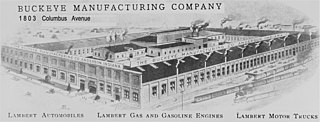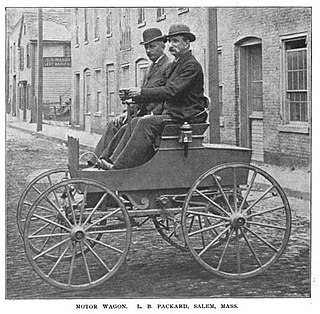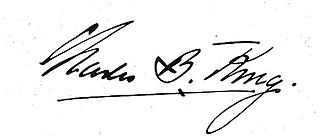Related Research Articles

Columbia Motors was a Detroit, Michigan, United States based automobile manufacturer that produced automobiles from 1916 to 1924.

An antique car is an automobile that is an antique. Narrower definitions vary based on how old a car must be to qualify. The Antique Automobile Club of America defines an antique car as over 25 years of age. However, the legal definitions for the purpose of antique vehicle registration vary widely. The antique car era includes the Veteran era, the Brass era, and the Vintage era, which range from the beginning of the automobile up to the 1930s. Later cars are often described as classic cars. In original or originally restored condition antiques are very valuable and are usually either protected and stored or exhibited in car shows but are very rarely driven.

Horseless carriage is an early name for the motor car or automobile. Prior to the invention of the motor car, carriages were usually pulled by animals, typically horses. The term can be compared to other transitional terms, such as wireless phone. These are cases in which a new technology is compared to an older one by describing what the new one does not have.

The Brass Era is an American term for the early period of automotive manufacturing, named for the prominent brass fittings used during this time for such things as lights and radiators. It is generally considered to encompass 1896 through 1915, a time when these vehicles were often referred to as horseless carriages.
An automobile magazine is a magazine with news and reports on cars and the automobile industry.

Phelps Motor Vehicle Company was a manufacturer of automobiles in Stoneham, Massachusetts, between 1903 and 1905. In 1906 it was succeeded by the Shamut Motor Company.

John William Lambert was an American automobile manufacturer pioneer and inventor. He is the inventor of the first practical American gasoline automobile. He operated large manufacturing companies that made transmissions, stationary gas engines, farm tractors, commercial motor trucks, railroad inspection vehicles, and various gasoline driven street cars. He had over 600 patents. In 1891, he built a working gasoline automobile, one year before the Duryea Brothers constructed theirs.

The Union automobile was a vehicle manufactured by the Union Automobile Company from 1902 until 1905. It was designed by John William Lambert, who had developed the three-wheel Buckeye gasoline buggy in 1891. Over the next decade, Lambert substantially refined the vehicle, with modifications including an additional wheel, a more powerful engine, and a new transmission system. The Union Automobile Company was formed as a subsidiary of Lambert's Buckeye Manufacturing Company solely to manufacture the Union, which took its name from Union City, Indiana, the city where it was built and which endorsed its production. In total, the company built over three hundred Union automobiles, before development shifted to the Lambert automobile, the Union's successor.

The Lambert Automobile Company developed as a 300,000-square-foot (28,000 m2) automobile factory in Anderson, Indiana. It manufactured the Lambert automobile, truck, fire engine and farm tractor as a part of the governing Buckeye Manufacturing Company. Lambert manufactured vehicles from 1905 to 1915. In 1910 the company had over a thousand employees, and from 1910 to 1915 the production had reached about three thousand vehicles per year. It went out of business in 1917 because of World War I.

Schacht was an American marque of automobiles and High-wheelers from 1904 to 1913, in Cincinnati, Ohio. The Schacht Manufacturing Company, later renamed Schacht Motor Car Company produced over 9,000 automobiles. The company was reorganized as the G.A. Schacht Motor Truck Company in 1914 and production of trucks and fire trucks continued until 1938.

The Davidson-Duryea gun carriage was a 3- and 4-wheeled armed armored vehicle manufactured in 1898 and 1899 for military use.

The Partin Manufacturing Company was a brass era American automobile manufacturer, headquartered at 29 South LaSalle Street, Chicago, Illinois from 1913 to 1917. The Partin-Palmer automobile and Pioneer cyclecar were produced.

The Buckeye Manufacturing Company was a company founded in 1884 by John William Lambert and his family members originally to manufacture horse drawn buggy parts in Union City, Ohio. The enterprise started with $2,000 and six men and some helper boys. The company got involved in making tools and one early horseless carriage automobile.

The Union Automobile Company was an automobile factory to manufacture the Union automobile through the Buckeye Manufacturing Company. It began manufacturing automobiles in 1902 and produced them through 1905. The company was located in Union City, Indiana. The inventor of Union automobile gasoline engine and friction drive gearless transmission was John W. Lambert. In the early part of 1905 the company moved to Anderson, Indiana. It had produced 325 automobiles before going out of business in the later part of 1905. It was replaced with a redesigned model that became the Lambert automobile.

Lucius B. Packard (1836-1914) was an American wheelwright, cabinetmaker and automobile pioneer in the Veteran Car Era. He built his first Velocipede in Peabody, Massachusetts in 1860, followed by a "real" bicycle in 1879 that was built in Salem, Massachusetts.

Charles Brady King was an American engineer and entrepreneur remembered as an automotive pioneer, artist, etcher, musician, poet, architect, mystic, industrialist and inventor.

The American Motor League ("AML") was the first automobile organization in the United States, formed 1895. The AML started in Chicago from ideas of Charles Brady King. He wished to form an organization that governed the movement of the fast development of the manufacture of "horseless carriages" that seemed to be going in various haphazard directions in the United States. The AML was organized by King and he was given the first membership each year, No. 100.

The Worthington Automobile Company was a short-lived automobile manufacturer in the United States that made automobiles between 1904 and 1905.
Robert Craig Hupp, commonly called "Bobby", was an American automobile engineer and company founder.
Ajax Motor Vehicle Company was a now-defunct American brass era electric car manufacturer established in New York City, which operated from 1901 until 1903. It produced the Ajax Electric car. Its factory was located at 220 West 36th Street, just north of the famed Macy's Department Store in Manhattan.
References
- ↑ The Horseless Age: The Automobile Trade Magazine. Horseless Age Company. 1899.
- ↑ Kimes, Beverly Rae; Clark, Henry Austin (September 2, 1996). Standard Catalog of American Cars 1805-1942 (3rd, illustrated ed.). Iola, Wisconsin, USA: Krause Publications. ISBN 9780873414289. OCLC 34905743.